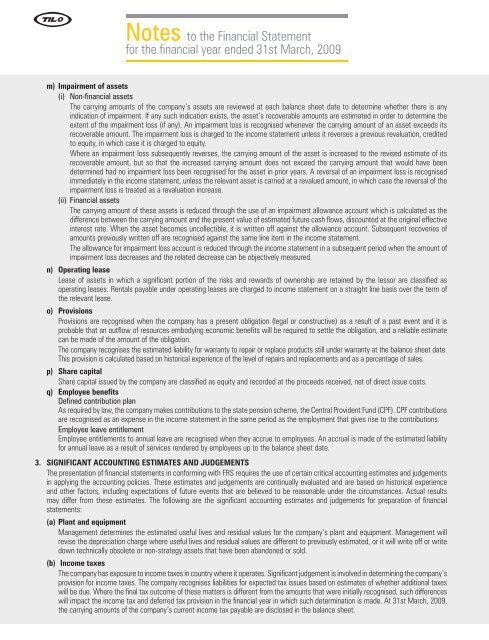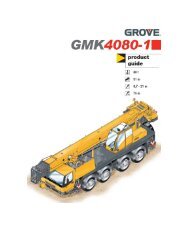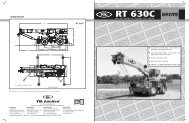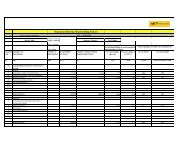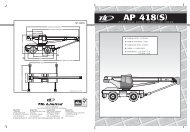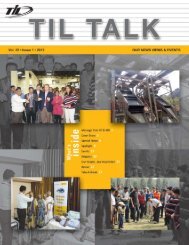view / download the documents. - til india
view / download the documents. - til india
view / download the documents. - til india
- No tags were found...
Create successful ePaper yourself
Turn your PDF publications into a flip-book with our unique Google optimized e-Paper software.
Notes to <strong>the</strong> Financial Statementfor <strong>the</strong> financial year ended 31st March, 2009m) Impairment of assets(i) Non-financial assetsThe carrying amounts of <strong>the</strong> company’s assets are re<strong>view</strong>ed at each balance sheet date to determine whe<strong>the</strong>r <strong>the</strong>re is anyindication of impairment. If any such indication exists, <strong>the</strong> asset’s recoverable amounts are estimated in order to determine <strong>the</strong>extent of <strong>the</strong> impairment loss (if any). An impairment loss is recognised whenever <strong>the</strong> carrying amount of an asset exceeds itsrecoverable amount. The impairment loss is charged to <strong>the</strong> income statement unless it reverses a previous revaluation, creditedto equity, in which case it is charged to equity.Where an impairment loss subsequently reverses, <strong>the</strong> carrying amount of <strong>the</strong> asset is increased to <strong>the</strong> revised estimate of itsrecoverable amount, but so that <strong>the</strong> increased carrying amount does not exceed <strong>the</strong> carrying amount that would have beendetermined had no impairment loss been recognised for <strong>the</strong> asset in prior years. A reversal of an impairment loss is recognisedimmediately in <strong>the</strong> income statement, unless <strong>the</strong> relevant asset is carried at a revalued amount, in which case <strong>the</strong> reversal of <strong>the</strong>impairment loss is treated as a revaluation increase.(ii) Financial assetsThe carrying amount of <strong>the</strong>se assets is reduced through <strong>the</strong> use of an impairment allowance account which is calculated as <strong>the</strong>difference between <strong>the</strong> carrying amount and <strong>the</strong> present value of estimated future cash flows, discounted at <strong>the</strong> original effectiveinterest rate. When <strong>the</strong> asset becomes uncollectible, it is written off against <strong>the</strong> allowance account. Subsequent recoveries ofamounts previously written off are recognised against <strong>the</strong> same line item in <strong>the</strong> income statement.The allowance for impairment loss account is reduced through <strong>the</strong> income statement in a subsequent period when <strong>the</strong> amount ofimpairment loss decreases and <strong>the</strong> related decrease can be objectively measured.n) Operating leaseLease of assets in which a significant portion of <strong>the</strong> risks and rewards of ownership are retained by <strong>the</strong> lessor are classified asoperating leases. Rentals payable under operating leases are charged to income statement on a straight line basis over <strong>the</strong> term of<strong>the</strong> relevant lease.o) ProvisionsProvisions are recognised when <strong>the</strong> company has a present obligation (legal or constructive) as a result of a past event and it isprobable that an outflow of resources embodying economic benefits will be required to settle <strong>the</strong> obligation, and a reliable estimatecan be made of <strong>the</strong> amount of <strong>the</strong> obligation.The company recognises <strong>the</strong> estimated liability for warranty to repair or replace products s<strong>til</strong>l under warranty at <strong>the</strong> balance sheet date.This provision is calculated based on historical experience of <strong>the</strong> level of repairs and replacements and as a percentage of sales.p) Share capitalShare capital issued by <strong>the</strong> company are classified as equity and recorded at <strong>the</strong> proceeds received, net of direct issue costs.q) Employee benefitsDefined contribution planAs required by law, <strong>the</strong> company makes contributions to <strong>the</strong> state pension scheme, <strong>the</strong> Central Provident Fund (CPF). CPF contributionsare recognised as an expense in <strong>the</strong> income statement in <strong>the</strong> same period as <strong>the</strong> employment that gives rise to <strong>the</strong> contributions.Employee leave entitlementEmployee entitlements to annual leave are recognised when <strong>the</strong>y accrue to employees. An accrual is made of <strong>the</strong> estimated liabilityfor annual leave as a result of services rendered by employees up to <strong>the</strong> balance sheet date.3. SIGNIFICANT ACCOUNTING ESTIMATES AND JUDGEMENTSThe presentation of financial statements in conforming with FRS requires <strong>the</strong> use of certain critical accounting estimates and judgementsin applying <strong>the</strong> accounting policies. These estimates and judgements are continually evaluated and are based on historical experienceand o<strong>the</strong>r factors, including expectations of future events that are believed to be reasonable under <strong>the</strong> circumstances. Actual resultsmay differ from <strong>the</strong>se estimates. The following are <strong>the</strong> significant accounting estimates and judgements for preparation of financialstatements:(a) Plant and equipmentManagement determines <strong>the</strong> estimated useful lives and residual values for <strong>the</strong> company’s plant and equipment. Management willrevise <strong>the</strong> depreciation charge where useful lives and residual values are different to previously estimated, or it will write off or writedown technically obsolete or non-strategy assets that have been abandoned or sold.(b) Income taxesThe company has exposure to income taxes in country where it operates. Significant judgement is involved in determining <strong>the</strong> company’sprovision for income taxes. The company recognises liabilities for expected tax issues based on estimates of whe<strong>the</strong>r additional taxeswill be due. Where <strong>the</strong> final tax outcome of <strong>the</strong>se matters is different from <strong>the</strong> amounts that were initially recognised, such differenceswill impact <strong>the</strong> income tax and deferred tax provision in <strong>the</strong> financial year in which such determination is made. At 31st March, 2009,<strong>the</strong> carrying amounts of <strong>the</strong> company’s current income tax payable are disclosed in <strong>the</strong> balance sheet.


